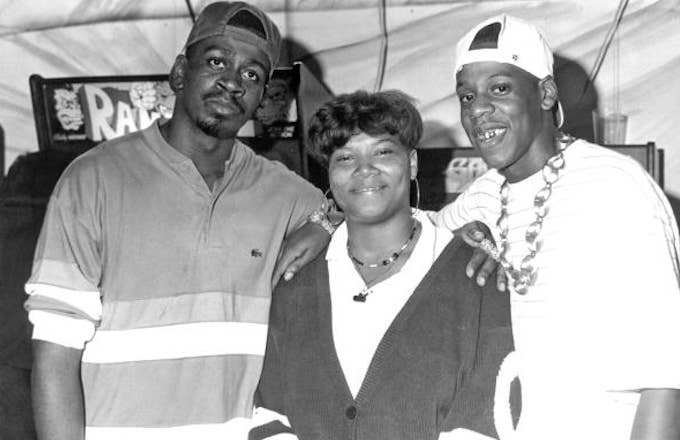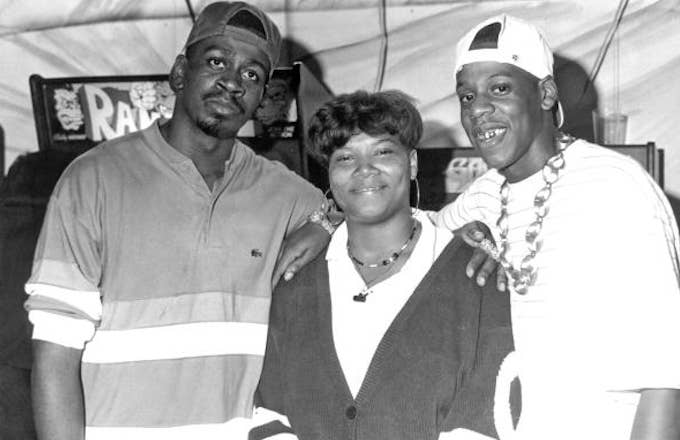
The imminent release of Jay Z's surprise album/movie/whatever-the-hell-it-is 4:44 on Friday has the music world in a frenzy. But why? How is it that a rapper half a year shy of turning 48 is dominating an ostensibly youth-based culture like hip-hop?
While it may seem natural that Hov is dominating headlines, there are few other rappers of his generation who can still command the rap world's attention. For context, Jay is only a year younger than Big Daddy Kane, who hasn't released a new album since 1998, and whose frequent live performances are defined by songs recorded before 1990. Likewise, Kool G. Rap was born just a year before Hov; he released a new album less than a month ago, but it's unlikely you heard about it unless you're a dyed-in-the-wool traditionalist. Rakim was also born in 1968 (what was in the water that year?), and is similarly reliant on performing 30-year-old songs. The other veteran rappers who can still take up a good share of the current conversation, people like Nas and Eminem, are younger than Jay by a few years.
So how has he done it? How has Jay Z continued to have everyone talk about his latest moves, while his closest contemporaries are reliant on their back catalogs?
There's not one simple answer. Rather, Shawn Corey Carter has combined talent with a series of incredibly savvy moves over the years. Ironically, perhaps the biggest key to Jay's success, though, is his early failure.
Hov was always a great rapper. DJ Clark Kent, not someone who is easily impressed, heard a teenage Jay rap and thought even then that he was already "the best rapper I've ever heard." Despite that, and even though Kent put Jay on as many records as he could, success remained elusive. Jay was an ancient-by-rap-standards 26 when his debut album came out in 1996. Had he scored early hits like his former mentor Kane, it's certainly possible that he'd be remembered today as a talented but unformed double-time rapper. Instead, entering the game so late meant he had time to learn, to see the mistakes other people made, and most importantly to live, so he had something to rap about.
And once he walked through the door, he wasn't leaving. From 1996-2003, Jay released an album every year, along with at least another album's worth of remixes, guest appearances, and freestyles. No vacations, no hiatuses, no time off. Oh, and in the middle of all that he managed to tour, sign, and mentor other artists, and start a successful clothing company. What he accomplished in those "seven straight summers" gave him a body of work to draw on for the rest of his career.
While Jay first tasted massive commercial success with his 1998 album Vol. 2... Hard Knock Life, it was something that happened several years later that really moved him from being a successful rapper to the rapper. And that was an event no one could have predicted.
The Blueprint was released on September 11, 2001—a day that would give us the largest attack on U.S. soil since Pearl Harbor. And yet, the album still sold a staggering 420,000 copies in its first week. This—the idea that not even a terrorist attack could stop Jay Z's success—gave Hov's place at the top of the rap game an inevitable feeling that never left. And he knew it.
"Bootleggers, bombing, Bin Laden—I'm still crackin'," he rhymed just five days after the incident. "I dropped the same date as the Twin Towers/I show power/Still I show compassion for others, send money and flowers."
True to his lyrics, Jay was never callous or minimizing about the connection. On the Blueprint Lounge Tour in the immediate aftermath, he donated money from each ticket to a 9/11 foundation, and would continue to raise money for victims of the attack in the years to come. But the album release and the day's more tragic events would continue to be linked. "Rumor has it, The Blueprint classic," he rapped on 2002's "The Bounce." "Couldn't even be stopped by Bin Laden."
Another reason for Jay's continued success is that it never feels like it's solely about him. While he has no doubt enjoyed being half of a billion-dollar power couple, Jay has from the beginning made his career wins feel like they're really victories for a much larger group. A seemingly throwaway line from The Blueprint's first single really gets to the heart of the issue.
"I do this for my culture/To let ’em know what a nigga look like when a nigga in a roadster," he says on "Izzo (H.O.V.A.)" And that remains his position—that his very public success is a way to show the world that an African-American who grew up where the hammers rung and news cameras never come can be successful not only selling 92 bricks on the street, but selling IPOs and reverse mergers in the boardroom. This continued even during Hov's short-lived "retirement," when he temporarily stopped making music in order to step into the presidency of Def Jam.
There is a whole lot more that has gone into maintaining Jay's relevance. He has had an unerring eye for picking up on trends at just the right time, from Southern rap (see his "Ha" remix and "Big Pimpin'," both of which were years before the South's current dominance of the game began) to "chipmunk" soul samples (which would become ubiquitous in the few years after The Blueprint dropped) to using performance and fine art in his work. Oh, and having the hottest chick in the game wearing your chain certainly doesn't hurt.
Matter of fact, Beyoncé's role in her husband's continued relevance should not be underestimated—especially since she's making century-defining art that may or may not divulge the secrets of the couple's private life. Part of the reason why 4:44 is so hotly anticipated is because of the light it might shed on whatever marital strife, real or exaggerated, fed into the creation of Lemonade. The film showed us a different side of Hov, and showed that he's willing to mature and change with the times. The early teases of 4:44—in particular the clip with Moonlight's Mahershala Ali accompanied by Jay rapping about his father—suggest that it will be an unprecedented act of self-reflection on Jay's part. Even if it isn't, Jay has taken a page from Beyoncé's playbook and created an album that doubles as a medium-blending pop culture event. And for fans who just care about the music, that veteran Chicago producer No I.D. is supposedly shaping the final product means that the project should be tight and focused; No I.D. does not tolerate mess.
Jay Z has managed the all-too-rare feat of growing up and growing older while remaining relevant. Now, he's back at the lifetime project of remaining relevant, teasing a project that no one knows the shape of for a release at midnight tonight. In a genre as young as hip-hop (Jay was in grade school when the first rap records appeared), this is a path that is still largely uncharted, and we'll all be watching to see how he continues to negotiate this new territory.


